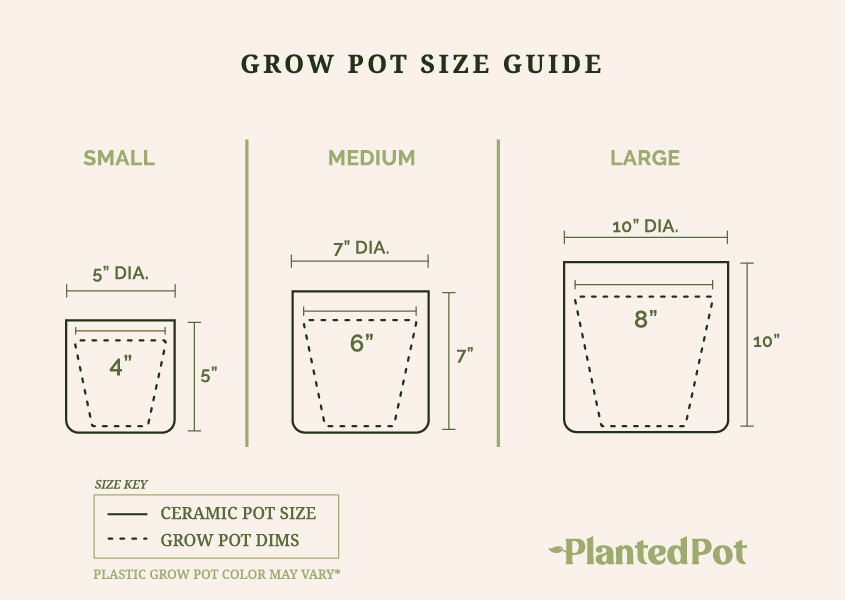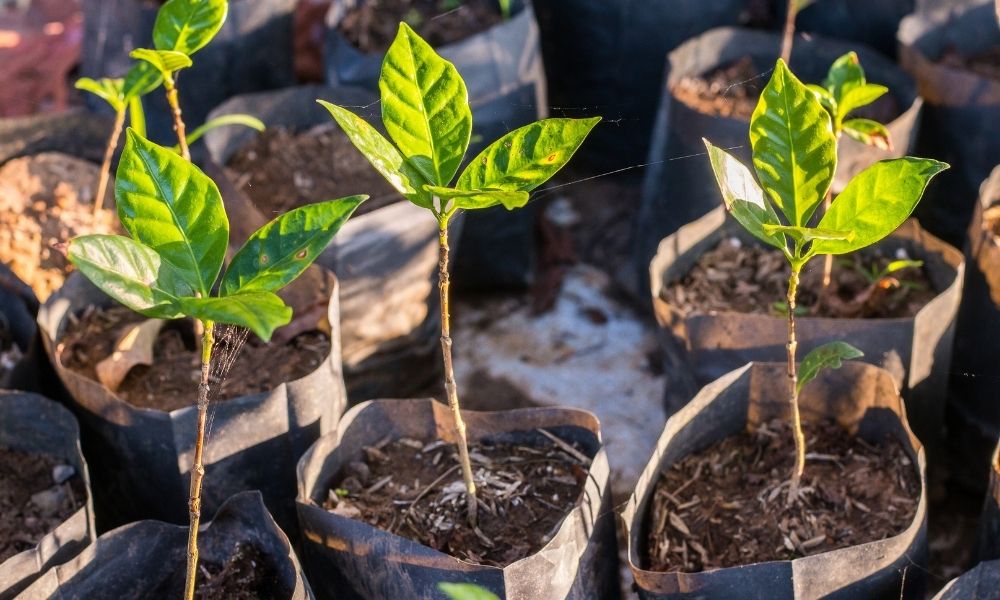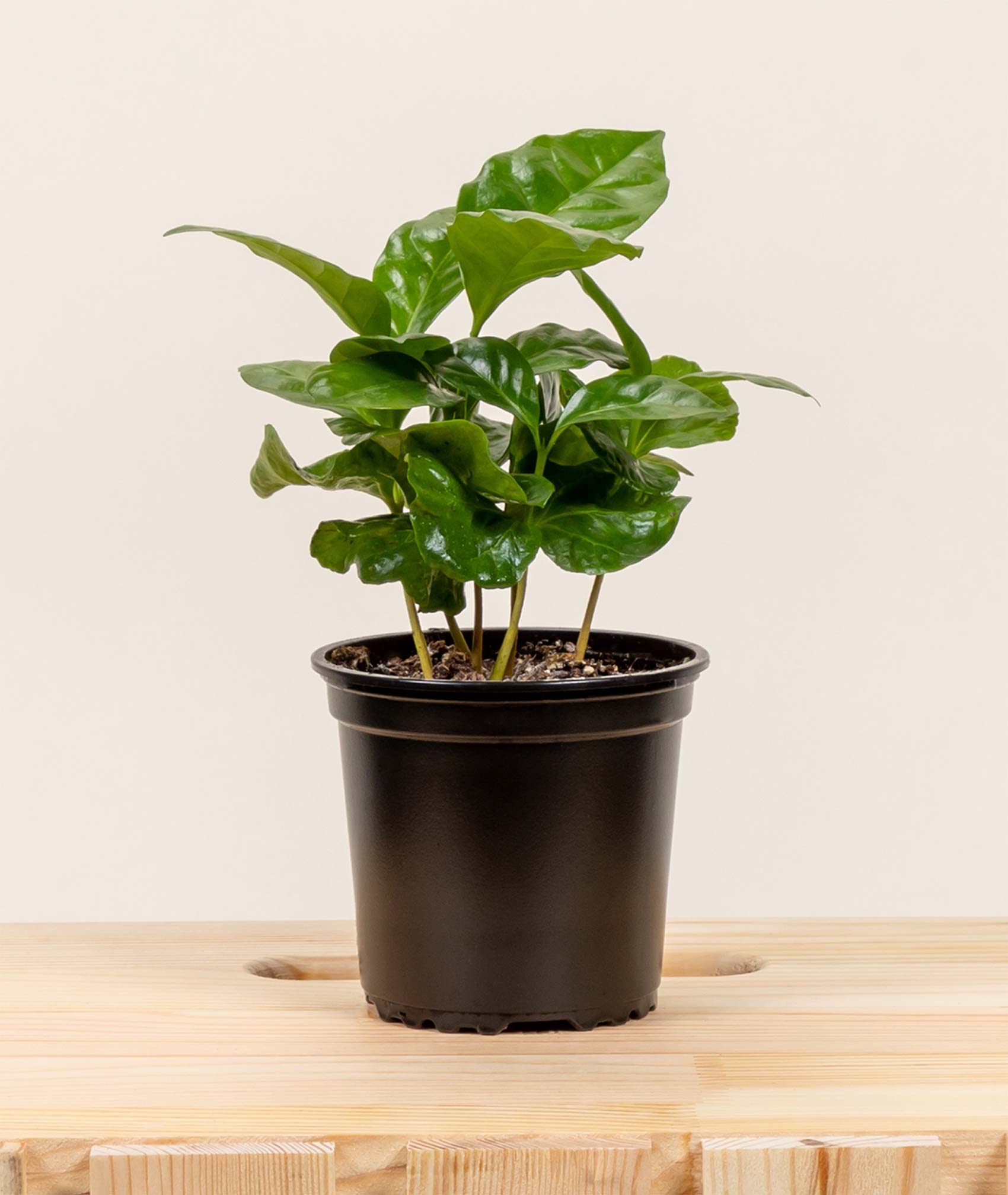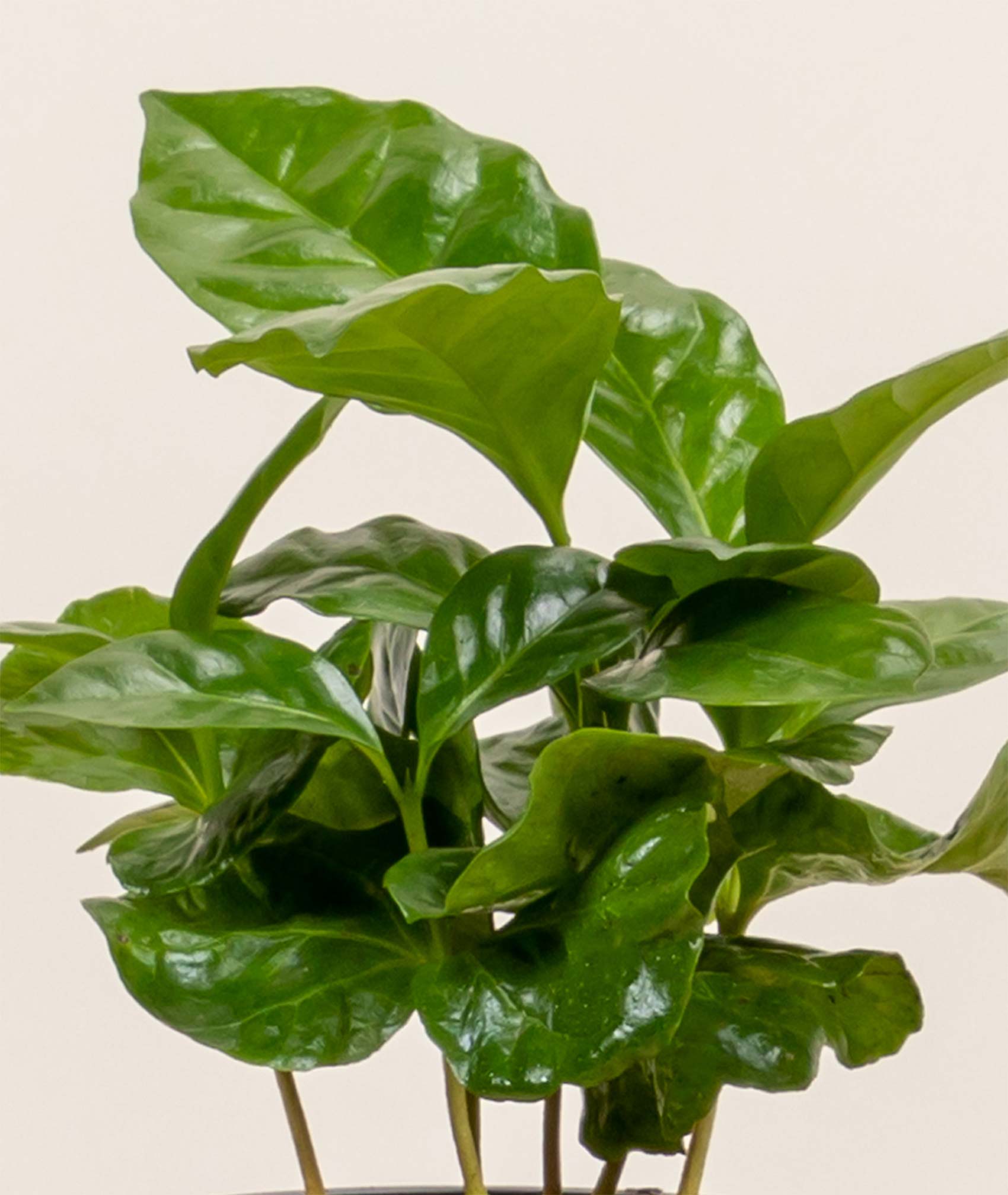
Arabica Coffee Plant
$18
 Plastic grow pots come in different colors, you may receive a black or rust colored pot.
Plastic grow pots come in different colors, you may receive a black or rust colored pot.
Ah, life’s two greatest gifts: house plants and coffee. Why should you have to choose between one or the other? With the Arabica Coffee house plant, you don’t have to! Save yourself a trip to the grocery store (and a couple of bucks) by growing your coffee in the comfort of your own home. Too often, we’re unsure what chemicals or additives are mixed into our food and drinks. Coffee is America’s favorite beverage, so we should have complete control over it. With the Arabica Coffee plant, you can grow your coffee exactly as you see fit while having a pretty piece of nature in your home at the same time.
Partial Shade
Keep the soil moist but not soggy
64° – 70°F
Related Products
Arabica Coffee Plant
The Arabica Coffee Plant is not only beautiful but beneficial to your health. With its dark green leaves, bushy growth, and coffee beans (yes, really!), this plant is an exciting addition to any home.
Used to a tropical environment, the Arabica Coffee Plant does have some specific care requirements. But overall, it’s pretty easy to care for as an indoor plant. And for many people, the benefits — fresh coffee and pungent scent — are worth it! Let’s take a look at what it takes to grow an Arabica Coffee Plant!
What is an Arabica Coffee Plant?
The Arabica Coffee Plant is a large and compact plant with glossy green leaves, making them the perfect plant for any living space and decor design. Even though their dark leaves are enough to get a fair amount of attention, this plant sprouts alabaster white flowers and small berries in the spring.
The Arabica Coffee Plant gets its name because of its small plump berries. Starting at just half an inch, the berries eventually darken, turning from green to black. Each pod contains two seeds. These seeds grow to be coffee beans! Just keep in mind that it will take a few years for this plant to produce flowers and fruits.
This unique plant is native to Ethiopia and tropical Africa. In its natural environment, the Arabica Coffee Plant is considered a small tree. It’s a different story in your home, however, where the size is managed through pruning.
How To Care For Your Arabica Coffee Plant
Below is a rundown on the Arabica Coffee Plant and what new plant parents should expect when caring for this delightful shrub.
Plant Size: Arabica Coffee Plants can grow up to 15 feet tall and eight feet wide when planted in the ground. They won’t get as big when potted but they are still a pretty impressive plant that can grow up to six feet if given the right conditions.
Light Requirements: The best way to get your Arabica Coffee Plant to grow large and vibrantly is to give them bright, indirect sunlight. They can even tolerate full sunlight in areas with less sun. But make sure they are never in harsh, direct light since they are used to being under a forest canopy in the wild. Their leaves will turn brown if exposed to too much direct sunlight.
Water Requirements: The Arabica Coffee Plant is a water lover. This is not a plant you can ignore for days on end. It needs regular watering — the soil should always be evenly moist and the water never dried out completely. Just be sure the plant is never waterlogged because they could experience root rot.
Temperature Requirements: As you could probably guess from this plant’s native home, the Arabica Coffee Plant prefers warmer weather. A preferred home temperature when caring for your Arabica Coffee Plant is 70 to 80 degrees Fahrenheit. At night it should only get as low as 65 degrees.
The more regulated your home’s temperature, the faster your plant will grow. However, in the spring, higher temperatures are not as ideal for Arabica Coffee Plants that are growing beans. Fruits need to ripen at a slower and steadier pace.
When it comes to humidity, this is a plant that prefers highly humid conditions. They’re used to rain and fog in their native environment, keep your home’s humidity level at 50 percent or more. If the air is too dry in the room they’re in, the leaf edges will begin to yearn brown. It can help to mist your plant daily or put a humidifier near your plant.

Why Choose an Arabica Coffee Plant for Your Home?
The Arabica Coffee Plant is a great addition to any home in need of some glossy greens. It’s a vigorous grower that can brighten up any space, make you feel refreshed and happy, and even cut down on your coffee spending. Here are some of the benefits of owning this special plant.
It’s Beautiful
With its large, dark green leaves and dainty tree-like shape, the Arabica Coffee Plant is a stunning addition to any room. Whether it’s in your living room or office, this plant will create a sense of balance no matter the decor. The Arabica Coffee Plant looks even more striking when it starts blooming and growing seeds in the spring.
It Smells Good
Looking for a subtle way to make your room more inviting? In the spring, the blossoms that develop on the Arabica Coffee Plant are known to smell, making any room feel more relaxing and comforting.
If you need a lesson in philosophy, the Arabica Coffee Plant has something to teach: patience is a virtue. These majestic blooms won’t happen for the first few years (sometimes it can take up to eight!). With determination though, these sprouts can represent much more than a green thumb.
Purifies Air
NASA recently performed a study on air purification power and found that most plants can free a home or office space of harmful contaminants in the atmosphere. While it helps to have an abundance of plants around, even just one Arabica Coffee Plant will make you feel refreshed.
The large, dark leaves are more than just beautiful features. Plants improve air quality with photosynthesis, which is the process of recycling carbon dioxide into oxygen. The bigger the leaves, the more oxygen produced! This means that the Coffee Plant will improve the air quality of any room it’s in!
Increased Productivity
Studies have shown that having a touch of greenery in your home or office can improve your productivity as well. Keep your plant near your desk to feel clear-headed, creative, and inspired. Put one in your living room to help you stay alert while answering emails or cleaning. You’ll feel less stressed and more positive when you have this plant around!
Improved Mood
There are many studies floating around that prove having green around can improve your mood. Having a Coffee Plant around can make you feel connected to nature, relaxed, and positive. Put this plant in your bedroom or living room to promote a calming vibe.
Are Arabica Coffee Plants Good Indoors & Outdoors?
The Coffee Plant, despite being from such a tropical, humid place, does well indoors. To properly thrive, this plant species is a bit demanding — it needs bright, indirect light, daily misting, and warm temperatures. You should also consider feeding your Arabica Coffee Plant weak liquid fertilizer during the growing season.
When it comes to soil, your plant needs a rich, peat-based potting soil with excellent drainage. This plant also prefers acidic soil. The goal is to get it up to 6 to 6.5 pH.
You’ll need to repot your Coffee Plant every spring. Increase the pot size gradually, making sure each container has drainage holes. You will also need to regularly prune this plant to keep it at a manageable size for the space you plan to store it.
When the plant is older, you can even harvest coffee beans. This is often possible after three to five years. You’ll notice that your plant will start to produce fruit. Here’s a list of how to harvest those bodacious berries!
How To Harvest!
- Wait until the fruits that grow on the ends of your Arabica Coffee Plant have ripened to a ruby red and are slightly soft to pick them off the plant.
- In a bowl of water, pulp the cherries to separate the inner coffee beans from the fruit.
- Once separated, lay the beans on a wire mesh and let them dry until the skins don’t flake off. This process often takes up to a week or two. Once dried, these beans grow in a coffee mill.
You can also grow the Coffee Plant outside if you live in a warmer climate! Here’s how:
- Place the pot in a patio or even grow them in a garden. But make sure the temperature doesn’t drop below 64 degrees Fahrenheit because the plant won’t grow fruit. If you don’t live somewhere that’s warm all year round, you’re better off growing the plant inside so you can better control the heat and humidity levels.
Are Arabica Coffee Plants Pet and Children Friendly?
They are not! This plant is not safe to have around pets and children.
Every part of the Arabica Coffee Plant is toxic to all animals and people. This includes cats, dogs, horses, and even birds. Every part of the plant is toxic to humans too except for the mature fruit (or coffee bean).
The Coffee Plant is listed under “minor toxic,” meaning it’s non-fatal but will cause intestinal discomfort. Here are some symptoms to look for if you believe you or someone else has ingested the Arabica Coffee Plant:
- Vomiting
- Diarrhea
- Nausea
- Loss of appetite
If you have a particularly curious pet or kid it’s probably best to keep this plant in an off-limits space. If your pet is able to access all parts of the home, this might not be a safe plant to keep indoors. It also shouldn’t be grown outside if you have a horse.
Arabica Coffee Plant Family Relatives
The Arabica Coffee Plant is from the Rubiaceae plant family. This flowering plant family is commonly known as the Coffee, Madder, or Bedstraw family. There are about 13,500 species and 620 genera, including trees, shrubs, and herbs.
The Madder plant family can be found in a lot of areas around the world. Therefore, the largest species diversity is located in the tropics and subtropics. Here are some of the most popular species available in this family.
- Coffea: This is the source of coffee. There are over 12o species of Coffea. Their seeds contain a large amount of caffeine. It’s one of the world’s most valuable plants, usually juiced and exported.
- Cinchona: This genus of flowering plants contains 23 species of trees and shrubs that are all native to the tropical Andean forests of western South America.
- Gardenia: Native to the tropical and subtropical regions of Africa, Asia, Madagascar, and Australia, this genus includes evergreen shrubs and small trees. They often have flowers that are white or pale yellow. Flowering is from about mid-spring to mid-summer, and many species are strongly scented.
- Pentas: This is a flowering plant found in tropical and southern Africa, as well as Madagascar and the Arabian Peninsula. Their leaves are hairy and green and their flowers bloom in clusters of red, white, pink, and purple. This is a plant that attracts butterflies and hummingbirds!

Plants That Are Similar to the Arabica Coffee Plant
Already sold on the Arabica Coffee Plant and are looking for more? Here are some plant species similar to the Arabica Coffee Plant:
- Nana: This is a dwarf variety of the Arabica Coffee Plant. It only grows 12 inches, making it perfect for smaller indoor spaces. (Think studios or a study nook!)
- Coffea Canephora: This is more commonly known as Robusta Coffee. As the name suggests, the plants are robust. But you’ll notice the coffee beans are less favored because they are harsher in flavor.
- Coffea Liberica: Native to central and western Africa, this plant produces large fruits that have high caffeine content. But it’s more pleasant than the Robusta Coffee.
- Psychotria Nervosa: This is a Florida native that’s called Wild Coffee.
Final Thoughts – Arabica Coffee Plant
Arabica Coffee Plants are a fun plant to have in your home. So, they may be a little finicky, but with the right care, the Coffee Plant will thrive. And the benefits are worth it.
This plant is vibrant and beautiful. It adds a tropical touch to your home. It also helps keep your air a bit cleaner and can improve your mood. You’ll feel focused, creative, determined, and rejuvenated with plants around! Especially when you’re pumped off of the all-natural caffeine you grew from your very home.





Reviews
There are no reviews yet.